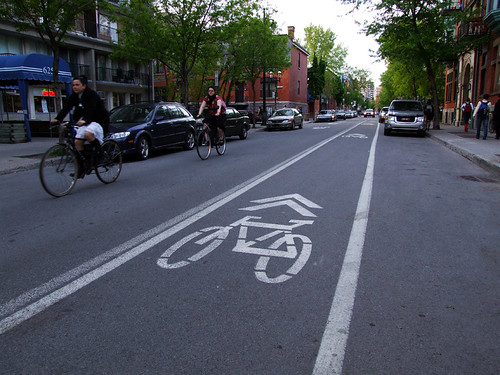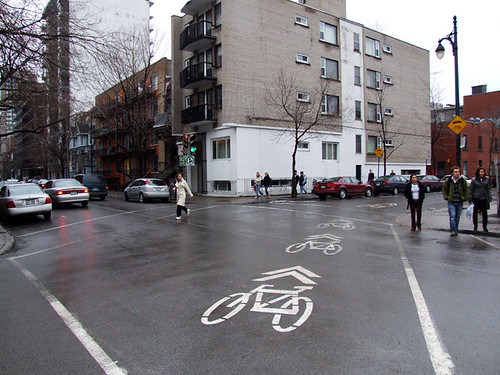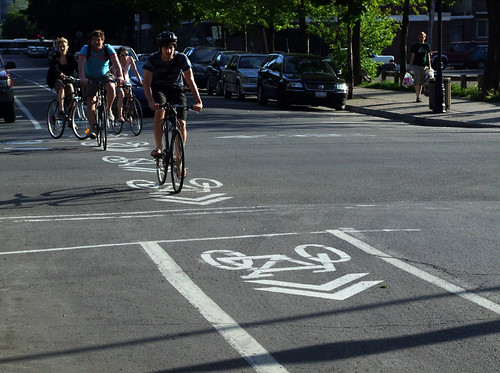Counterflow bike lane on Milton Street, near Lorne Avenue
A couple of days ago, Dale Duncan wrote on Spacing Toronto about sharrows, or shared road arrows, a new type of cycling-related road marking that is slowly becoming popular across North America. When I saw what they looked like — a bicycle symbol topped by two chevrons — I realized that Montreal has been using sharrows for a couple of years. The first time I saw them was in the McGill Ghetto, where in 2006, city workers painted them on Milton and Prince Arthur Sts., along with a couple of counterflow bike lanes.
As with any type of cycling infrastructure, cyclists are divided over the benefits and effectiveness of sharrows. Some criticize them for lulling cyclists into a false sense of security while doing little to remind drivers that they are legally bound to share the road with people on bikes. (The same argument is used against bike lanes, bike paths and just about every type of initiative that segregates cyclists and motorists.) Others, though, think they’re a good way to realign drivers and cyclists, getting bikes out of the dangerous “door zone” while reminding motorists that cyclists are present.
Sharrows, it seems to me, should be considered just one infrastructural tool among many. In the McGill Ghetto, a neighbourhood just east of the McGill University campus in downtown Montreal, they appear to work very well. Milton and Prince Arthur, parallel one-way streets heading in opposite directions, have long been used as the main east-west link from the Plateau Mont-Royal into the central part of downtown. As such, the number of bikes on these mostly residential streets is consistently high. (At 5pm on a Thursday last year, I counted 24 cyclists passing through the intersection of Milton and University in less than a minute.) Cyclists heading east from McGill have always rode against westbound traffic on Milton before switching over to eastbound Prince Arthur; cyclists heading west from the Plateau would ride against eastbound traffic on Prince Arthur before switching to westbound Milton.
Naturally, a large mass of cyclists heading against the traffic flow on these two streets was potentially dangerous for cyclists and motorists alike. For once, the city’s response was ingeniously simple: they established counterflow bike lanes on Milton for a few blocks east of McGill, using sharrows to direct cyclists towards Prince Arthur, where a normal bike lane took them east into the Plateau. Further east, at Prince Arthur and St. Laurent, another counterflow bike lane was built to lead cyclists to Clark Street, where sharrows direct them down to Milton Street.
So far, from what I have observed, the system is working. But that’s only because it is just that: a system. If the sharrows were used in isolation, without the bike lanes, I doubt they would be as successful. They also work because they are prominent — at intersections, four or five densely-packed sharrows are painted in succession, creating a clear path for bikes and making it impossible for drivers to ignore — and positioned in the centre of the road, rather than on the side where cyclists would be vulnerable to car doors.
Sharrows definitely have a place in our streets — but not in isolation and not as a replacement for bike lanes.
More photos of the Ghetto’s sharrows and bike lanes after the jump!
Sharrows on Milton at Hutchison
Bike lanes on Prince Arthur Street





7 comments
I’m living in Toronto now and remember fondly the daily bike commute along that route from the Plateau to my downtown workplace. It just seemed drivers “got it” through that area.
Contrast this with the placement of sharerows against the curbgutter of the Credit River bridge on Burnhamthorpe Rd in Mississauga. Clearly Mississauga is more concerned with showing cyclists their place and keeping them there than providing cyclists a safe place and educating motorists cyclists are entitled to roadspace.
There is a route in Toronto popular with people who want to go East-West without travelling on major streets. We often call it “the Parkdale backway.” I have dreamt of sharrows being painted on these streets many times.
Clair> You should go to http://www.bikely.com/ and post the route! Then tell us here that you did so.
Bikely lets you share your secret bike routes with everyone in a google mash up.
Interesting article, I’m always amazed at the innovation for bicycle and pedestrian infrastructure in Montreal. Sharrows are to be adopted by the City of Toronto according to a newsletter I picked up at the recent bike plan consultation. If you happen to be in Montreal and walk around the renewed area where the overpasses of Ave des Pins at Ave du Parc once stood there’s a crossing controlled by bicycle traffic signals with cute little bicycle pictograms in each lens. Oh, and I dig the no right on red rule on the Montreal Island. Another thing Toronto should catch onto at some intersections…
Thanks for this everyone! It’s very very helpful to see what is done elsewhere in Canada, and the frequency of these sharrows is a key point too, as I think we’ll be doing them as infrequently as possible to save paint as it costs money to put the paint on, and bikes are sooo hard on the roads eh?
Thanks for the thoughtful article. I agree sharrows work best when used as one element in a comprehensive bike network. The best bike systems (noteably, Danish and Dutch) recognize that low traffic streets need the least intervention, such as a sharrow, while heavy traffic streets need the separated cycle tracks. I just hope North America catches up and adopts the other half of the spectrum.